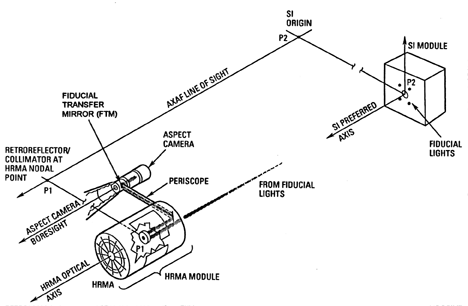
The aspect determination system is responsible for the collection of data that allow the pointing direction and roll angle of the Observatory to be reconstructed from the telemetry. The major parts of this subsystem are:
All work under the direction of the on-board computer, which uses their data to control the spacecraft during observations and slews.
The aspect camera and gyroscopes are mounted on the support structure assembly, which is attached to the (X-ray) optical bench of the Observatory. This means that the aspect camera and the gyroscopes are almost rigidly tied to the X-ray optical system, and variations in the aspect of the Observatory as determined by these units should trace variations in the aspect of the X-ray optics with high accuracy. Since the X-ray detectors (ACIS and HRC) may move slightly relative to the X-ray optics during an observation, the fiducial light assembly and the fiducial transfer system are provided to monitor their motions.
The principle by which this system operates is illustrated in Figure 4. The aspect camera views an area of sky around the nominal pointing direction of the observatory, imaging this region onto a CCD. Several bright stars in the field of view of the aspect camera are chosen as guide objects, and their positions on the CCD are measured using the brightnesses of pixels in small image patches.
Figure 4. A diagram illustrating the operation of the Aspect Determination System (ADS) on AXAF. The aspect camera views the optical sky directly, and fiducial lights arranged around a science instrument (SI at P2) via the fiducial transfer system (the retroreflector/collimator at P1, the periscope, and the fiducial transfer mirror). Up to eight objects are followed by the aspect camera --- normally five guide stars and three fiducial lights, and astrometry of these provides absolute coordinates and roll angle for the X-ray detector.
The relationship of the X-ray detectors to the optical field is established using the fiducial transfer system and the fiducial light assembly. Each X-ray detector is surrounded by a number of light-emitting diodes, which are observed by the aspect camera after passing though the fiducial transfer system, which consists of a large corner cube (the retro-reflector collimator), a fold mirror, a periscope leading from the center of the X-ray mirrors to the aspect camera, and a fiducial transfer mirror which makes the final fold of the beam. The positions of fiducial light images are measured in the same way as guide star images.
The aspect camera electronics calculates rough centroids for each guide star or fiducial light image, and passes these to the on-board computer for its fine pointing control. The individual pixel data in each image patch are inserted into the downlink telemetry, and are converted into accurate centroids on the ground. Astrometry using these centroids then allows celestial coordinates to be related to X-ray detector coordinates, via aspect camera coordinates.
This ideal process would not need the gyroscopes --- a sufficiently-precise, and sufficiently-sensitive aspect camera could produce accurate measurements of the pointing direction of the Observatory, and be used both for pointing control and reconstruction of the celestial coordinates of detected X-ray photons. In practice, the aspect camera cannot be used in this way, and the gyroscopes are used to provide the aspect solution on short time-scales.
The gyroscope signals are read more rapidly than the aspect camera signals, and hence provide a fine level of time sampling of the Observatory aspect. However, the gyroscope signals tend to drift, and need to be tied to a precise reference frame on the timescale of several aspect camera readouts. Thus the aspect camera data are used continuously to calibrate the gyroscopes, and the calibrated gyroscope data provide accurate relative positions for X-ray photons detected on the science instruments. The absolute positions of these photons are given by the absolute pointing direction of the Observatory, as determined by astrometry using the aspect camera's guide stars.
